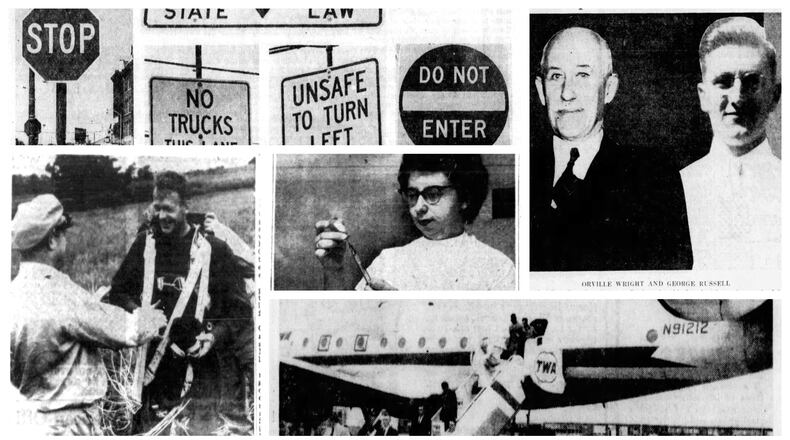Here’s a look at some stories from the week of Aug. 18-24.
Aug. 19, 1936: Orville Wright observes 65th birthday with his grandnephew
The man who was the first to fly turned 65 in 1936.
Orville Wright spent his birthday, as he did for many years, at his summer home on the 26-acre Lambert Island, in Sturgeon Bay, 90 miles northwest of Toronto.
With him for the summer was George Milton Russell, 21, the great-grandson of Orville’s father, Bishop Milton Wright. It was Russell’s fourth summer with Orville.
Russell’s grandfather was Reuchlin Wright, brother of Wilbur and Orville, who did not participate in their experiments.
Orville was known to return to Dayton soon after Labor Day, spending his days in his one-story brick laboratory, less than a block from his old bicycle shop.
Aug. 18, 1946: Veteran jumper get big kick as ‘pilot ejector’ throws him from plane
In 1946, First Sgt. Lawrence Lambert, stationed at Wright Field’s parachute branch, became the first person to use an automatic pilot ejection seat.
During his 11 years in the Army Air Force, the 29-year-old Lambert had made 58 jumps. The 59th was somewhat different.
He was a passenger in a Black Widow P-61, traveling at 6,000 feet and 300 miles an hour over the Patterson Field area when he became the first person to try such equipment in the United States.
“I lived a thousand years in that minute before Capt. John McGuyrt, the pilot, pulled the release,” Lambert said.
Lambert cleared the tail fin, as he was shot out of the plane. The seat traveled with him, propelled by a 37mm cartilage from a gun barrel. Three seconds later a small explosion automatically set off, releasing him from the seat. After three more seconds, the parachute automatically opened.
After a successful landing, Lambert expressed only one desire: To “get around the biggest steak available.”
Aug. 19, 1956: Area woman becomes first female doctor at Grandview hospital
Mary Theodoras, a doctor of osteopathy, set a milestone at Grandview hospital by becoming the first woman doctor on staff.
Along with 13 male colleagues, Theodoras joined the hospital staff the previous month to begin a year’s internship.
Theodoras, 24, of Vandalia, said that people no longer scoff at a woman doctor.
“Patients have been wonderful to me ever since coming here,” she said.
Interns were assigned to 14 different services during the year. Each service lasted 24 days and included training in every ward from maternity to obstetrics.
“I’m in the hospital by 7 every morning and never leave until about 9:30 p.m.,” she said.
Theodoras said she wanted to start her own practice in Dayton once her internship was up.
In 1996, the Ohio Osteopathic Association honored Theodoras (a past president of the organization), with the Distinguished Service Award.
Aug. 20, 1966: End of airline strike, machinists approve pact
At the time, it was considered the worst airlines walkout in U.S. history.
Members of the International Association of Machinists went on strike July 8 and didn’t vote to approve a new contact until Aug. 19.
Flights for TWA, United, Eastern, Northwest, National, Trans World and others were all stopped during the strike,
The local vote was 60-17 to approve new contract, which called for 5 percent increases for three years plus a cost of living guarantee.
Passengers were slow to return. United’s first flight from Dayton took off with just 15 boarding. TWA’s first flight only had nine. Officials believed business would pick up rapidly later that day.
Aug. 22, 1976: Dayton needs 60,000 signs to keep chaos off city streets
In 1976 a Dayton Daily News reporter posed a trivia question. How many signs — traffic, parking and street signs — are there in the city?
“More than 60,000 is a conservative estimate,” answered Ray Gano, a Dayton traffic engineering assistant.
Most of them were common and bought in bulk by the city, such as the 6,000 “STOP” signs at 2,800 intersections or the 1,000 “Yield” signs at about 600 intersections.
But every so often the city had to make signs by hand to fit a particular problem or situation.
One unusual sign was posted at Patterson Boulevard and East Second Street that said “okay” with an arrow off to the right to indicate that traffic could move over.
The most important ingredient in picking signs was that they be easily understood. The city once tested five different crosswalk signs to see which one got the message across the best.
Some signs had historical significance.
“The ‘do not enter sign,” with the red circle with a white bar across it goes back to medieval times and indicates a guard will defend the place with his life,” said Gano.
At the time, a 30-inch “STOP” sign cost about $25 to $30 to buy and install. A large, hand-made sign cold cost as much as $75.
About the Author






